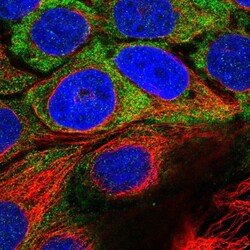HPA027398
antibody from Atlas Antibodies
Targeting: USH1C
AIE-75, DFNB18, harmonin, NY-CO-37, NY-CO-38, PDZ-73, PDZ73, PDZD7C
Antibody data
- Antibody Data
- Antigen structure
- References [7]
- Comments [0]
- Validations
- Immunocytochemistry [1]
Submit
Validation data
Reference
Comment
Report error
- Product number
- HPA027398 - Provider product page

- Provider
- Atlas Antibodies
- Proper citation
- Atlas Antibodies Cat#HPA027398, RRID:AB_10601775
- Product name
- Anti-USH1C
- Antibody type
- Polyclonal
- Description
- Polyclonal Antibody against Human USH1C, Gene description: Usher syndrome 1C (autosomal recessive, severe), Alternative Gene Names: AIE-75, DFNB18, harmonin, NY-CO-37, NY-CO-38, PDZ-73, PDZ73, PDZD7C, Validated applications: WB, IHC, ICC, Uniprot ID: Q9Y6N9, Storage: Store at +4°C for short term storage. Long time storage is recommended at -20°C.
- Reactivity
- Human, Mouse
- Host
- Rabbit
- Conjugate
- Unconjugated
- Isotype
- IgG
- Vial size
- 100 µl
- Concentration
- 0.1 mg/ml
- Storage
- Store at +4°C for short term storage. Long time storage is recommended at -20°C.
- Handling
- The antibody solution should be gently mixed before use.
Submitted references Defects in microvillus crosslinking sensitize to colitis and inflammatory bowel disease
A heterologous in-cell assay for investigating intermicrovillar adhesion complex interactions reveals a novel protrusion length-matching mechanism
A cryptic sequence targets the adhesion complex scaffold ANKS4B to apical microvilli to promote enterocyte brush border assembly
The small EF-hand protein CALML4 functions as a critical myosin light chain within the intermicrovillar adhesion complex
Brush border protocadherin CDHR2 promotes the elongation and maximized packing of microvilli in vivo
ANKS4B Is Essential for Intermicrovillar Adhesion Complex Formation
Proteomic analysis of the enterocyte brush border
Mödl B, Awad M, Zwolanek D, Scharf I, Schwertner K, Milovanovic D, Moser D, Schmidt K, Pjevac P, Hausmann B, Krauß D, Mohr T, Svinka J, Kenner L, Casanova E, Timelthaler G, Sibilia M, Krieger S, Eferl R
EMBO reports 2023;24(10)
EMBO reports 2023;24(10)
A heterologous in-cell assay for investigating intermicrovillar adhesion complex interactions reveals a novel protrusion length-matching mechanism
Weck M, Crawley S, Tyska M
Journal of Biological Chemistry 2020;295(48):16191-16206
Journal of Biological Chemistry 2020;295(48):16191-16206
A cryptic sequence targets the adhesion complex scaffold ANKS4B to apical microvilli to promote enterocyte brush border assembly
Graves M, Matoo S, Choi M, Storad Z, El Sheikh Idris R, Pickles B, Acharya P, Shinder P, Arvay T, Crawley S
Journal of Biological Chemistry 2020;295(36):12588-12604
Journal of Biological Chemistry 2020;295(36):12588-12604
The small EF-hand protein CALML4 functions as a critical myosin light chain within the intermicrovillar adhesion complex
Choi M, Graves M, Matoo S, Storad Z, El Sheikh Idris R, Weck M, Smith Z, Tyska M, Crawley S
Journal of Biological Chemistry 2020;295(28):9281-9296
Journal of Biological Chemistry 2020;295(28):9281-9296
Brush border protocadherin CDHR2 promotes the elongation and maximized packing of microvilli in vivo
Pinette J, Mao S, Millis B, Krystofiak E, Faust J, Tyska M, Nusrat A
Molecular Biology of the Cell 2019;30(1):108-118
Molecular Biology of the Cell 2019;30(1):108-118
ANKS4B Is Essential for Intermicrovillar Adhesion Complex Formation
Crawley S, Weck M, Grega-Larson N, Shifrin D, Tyska M
Developmental Cell 2016;36(2):190-200
Developmental Cell 2016;36(2):190-200
Proteomic analysis of the enterocyte brush border
McConnell R, Benesh A, Mao S, Tabb D, Tyska M
American Journal of Physiology-Gastrointestinal and Liver Physiology 2011;300(5):G914-G926
American Journal of Physiology-Gastrointestinal and Liver Physiology 2011;300(5):G914-G926
No comments: Submit comment
Supportive validation
- Submitted by
- Atlas Antibodies (provider)
- Main image

- Experimental details
- Immunofluorescent staining of human cell line CACO-2 shows localization to cytosol.
- Sample type
- Human
 Explore
Explore Validate
Validate Learn
Learn Western blot
Western blot Immunocytochemistry
Immunocytochemistry